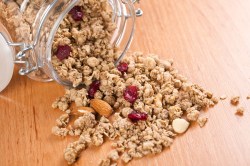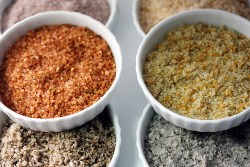Tired of Christmas cookies and jam? I try to give something edible every year, and here are some of my recent faves.
1. Granola
A few years back I was given some homemade granola and it changed my relationship with this cliché hippie food once and for all. Since then I’ve made it for myself and for friends and it’s always unique; sometimes I go really simple with nothing but oats, coconut, and pumpkin seeds. Sometimes I go for ginger and macadamias. And have you seen the cost of artisan granola these days? (I saw a jar for sale for $20 just last week. I kid you not.) Be warned: Once you get really good at making your own granola, you might find yourself craving it at odd hours and opting out of other meals.
Ingredients:
Real rolled oats: Quick oats or baby oats won’t work. If you’re making it to give away, you’ll want to buy around a quarter-pound per person.
Sweetener(s): Maple syrup tastes best, but it’s pricey. If you’re going to use it, I recommend mixing it with Agave syrup or honey. If you like your granola on the dark side, you could add a dab of molasses or some minced dates. I recommend trying a combination.
Oil: I like coconut and sunflower oil best, but anything neutral-flavored will work. I’ve even used light olive oil.
Nuts and/or seeds: The most affordable options are shredded coconut, sesame seeds, pumpkin seeds, and walnuts, but I like to add at least one big-ticket item if I’m making it as a gift, such as: pecans, macadamia nuts, slivered almonds, hazelnuts, or pistachios.
Fruit: The most affordable options are raisins, currants, and cranberries, but the options are many. Dried cherries, pears, or peaches make it fancy.
Spices: I like cinnamon, ginger, cardamom, and vanilla in my granola — but not all at once. Try them one or two at a time and see what works for you. If you want to get really crazy, add cacao nibs.
Salt: A crucial ingredient!
Preparation:
Preheat the over the 350 degrees F. Once you’ve assembled your favorite ingredients, make a small batch for yourself. Start with around four cups of oats, three-quarters of a cup of oil (coconut oil will need to be melted beforehand), a quarter-cup of sweetener, spices, and salt. Since this is a trial run, you can adjust your final batch based on how sweet/rich you like it. Generally more moisture = more clumps. Mix well (I use my hands, so that the oats get fully coated).
Spread the sticky oat mixture on a cookie sheet and place in the heated oven for around 20 minutes (this step will take 30 minutes or longer when you make your larger batch, and will need occasional stirring). Once the oats start to dry out and brown slightly, remove from the oven, stir, and add the nuts and/or seeds. Let it roast for another 10 minutes, then stir again. Remove the batch once the nuts are browned to your liking, add the fruit to the finished granola (so it doesn’t get dried out or burnt in the oven), and stir. Once the granola is cool, scoop it into pint-sized mason jars and decorate with ribbon, twine, or gift labels.
2. Flavored salt
A few years back I made flavored finishing salts for holiday gifts. I tried Meyer lemon, matcha (green tea powder), rosemary, and tomato-flavored salts, and that was just the tip of the iceberg. My friends liked the tomato salt best, which is so easy it borders on not really being homemade, but your friends don’t have to know that. The key is just to make sure that whatever you’re adding gets really, really dry.
Here’s the basic recipe: Take a lot of sun-dried tomatoes (either homemade or store-bought will work), put them in the oven on the lowest possible setting for an afternoon (overnight might be necessary, depending on your tomatoes). The goal is to let them go from sticky-dry to a more brittle, no-moisture-at-all dry.
 Take them out of the oven and put them in a food processor or coffee grinder, grind them to something resembling a powder, and add them to some large-grained sea salt. The ration I settled on was about one part tomato to three parts salt, but I recommend playing with it and seeing what works best for you. Commence putting said salt in pretty jars (bonus points if you’ve been saving your jam and Gray Poupon jars).
Take them out of the oven and put them in a food processor or coffee grinder, grind them to something resembling a powder, and add them to some large-grained sea salt. The ration I settled on was about one part tomato to three parts salt, but I recommend playing with it and seeing what works best for you. Commence putting said salt in pretty jars (bonus points if you’ve been saving your jam and Gray Poupon jars).
3. Pesto
I know what you’re thinking: Pesto is a summer food. And you’re right. But it’s also a great winter food. And I think it makes for a surprising gift — especially if you use high-quality olive oil and, you guessed it, put it in a pretty jar. In winter, my favorite pesto is made with dinosaur (Lacinato or black) kale, but I’m also a big fan of both arugula and nettle pesto. Because the latter is probably the least common, I’ll offer my wholly non-scientific recipe below.
If you’re making enough to give away, you’ll want to buy a really large bag of stinging nettles. They cook down a lot. (I recommend wearing gloves or plastic bags on your hands while handling them.) Boil a pot of water and blanch the nettles quickly (10-20 seconds is usually sufficient to get rid of the stingers. Then add the blanched nettles to a food processor with a few cups of walnuts, two or three cloves of garlic, some grated Pecorino Romano cheese, salt, and enough olive oil to fill the food processor around halfway up to the level of the nettle leaves. Puree. Once you have a smooth green paste, spoon it into jars and cover with a thin layer of olive oil. The pesto should last for several weeks in your friends’ fridges, where they can scoop it out to eat over pasta, on crackers as an appetizer, or drizzled over their scrambled eggs come January.
4. Lemon curd
Curd is like jam, but it’s decadent and British and it will make your friends feel extra sophisticated when they spread it on toast with their mid-afternoon tea. In fact, I think it’s what I’m going to make this year.
The secret to lemon curd’s richness is butter and eggs yolks, and I’ll be going with pasture-raised eggs. (All the cool kids are doing it.) Punk Domestics, my favorite recipe blog-aggregating site, has an impressive list of variations on the traditional recipe, including a grapefruit-scented lemon curd, one made with Meyer lemons, and one with vanilla and lavender if you want to get utterly, ridiculously fancy.
5. A DIY cookbook
This idea is kind of advanced (i.e. you need to have recorded some of your own recipes, or collected modified ones you like), but it’s also less messy than actually cooking. And it’ll last much longer. Blurb makes it super easy to collect your favorite recipes and food photos in one place. Of course, depending on your audience, I also think a homemade, ’90s zine-style Kinko’s cookbook makes a great gift.
Start this now for next year: Vin d’orange
Vin d’orange — wine flavored with oranges and aged — works best if you have access to Seville oranges (which are more bitter than most). I bottled some up last winter and I’ll be giving away about half of it and bringing the rest to holiday parties to share.
I used this recipe from chef and writer Samin Nosrat, but the web is full of recipes for similar projects, like this vin d’pamplemousse made with grapefruit. They’re easy to follow, and just require a little mixing, pouring, and a decent amount of cool space to store the bottles in for around a year. A little amnesia helps too, because making foods and drinks that require aging is all about delayed gratification. But a single Sunday afternoon spent working can result in a pretty cool holiday treat down the road. Cheers.








